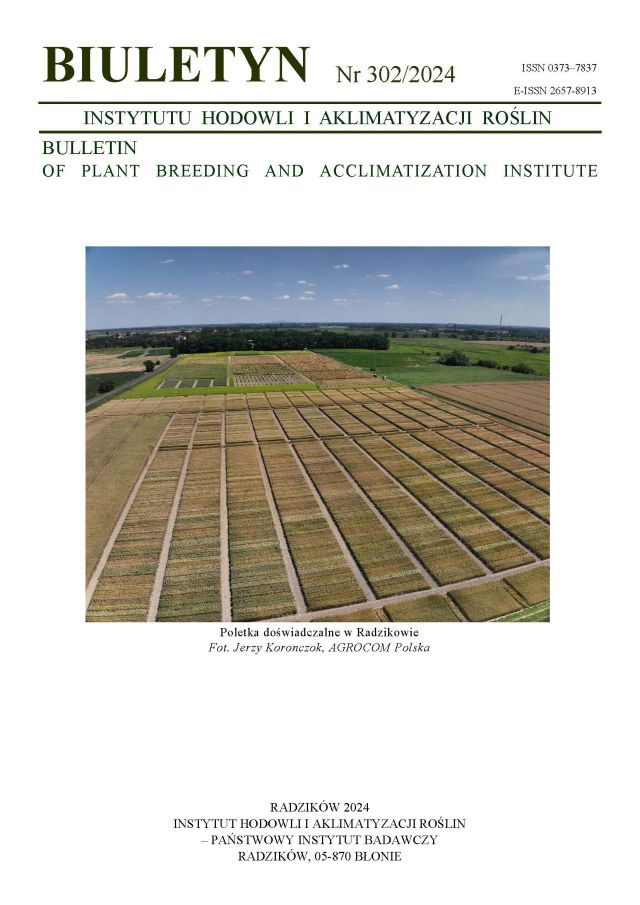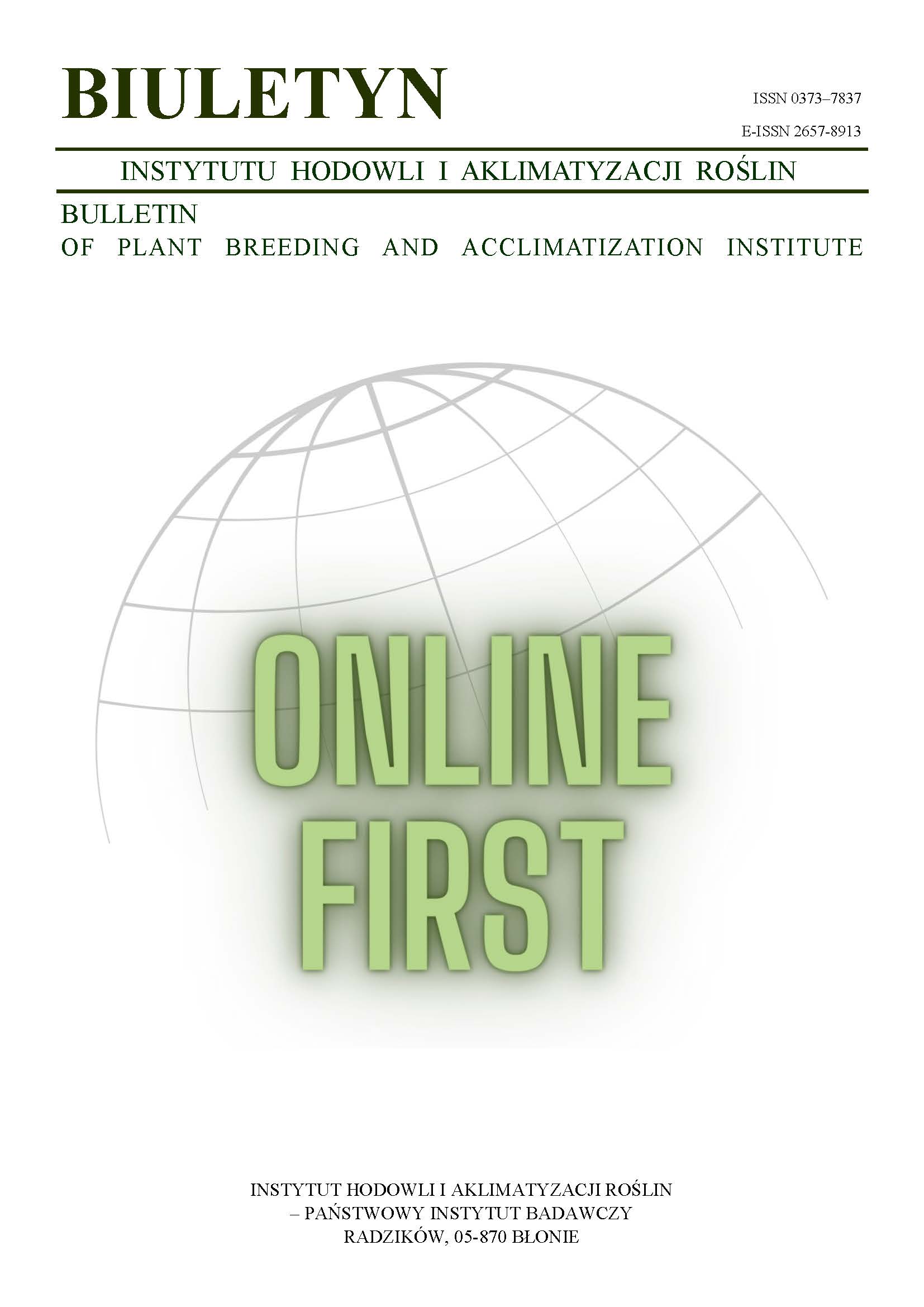Wybrane elementy nowoczesnych rozwiązań wpływające na skuteczność programów hodowlanych
Agnieszka Niedziela
a.niedziela@ihar.edu.plInstytut Hodowli i Aklimatyzacji Roślin — Państwowy Instytut Badawczy, Radzików (Poland)
Weronika Jarska
Instytut Hodowli i Aklimatyzacji Roślin — Państwowy Instytut Badawczy, Radzików (Poland)
Piotr T. Bednarek
Instytut Hodowli i Aklimatyzacji Roślin — Państwowy Instytut Badawczy, Radzików (Poland)
Abstrakt
Postęp hodowli roślin uzależniony jest od technologii pozwalających na identyfikację markerów cech ilościowych takich jak profilowanie DNA, czy też ich fenotypowanie. Coraz większe znaczenie zaczynają odgrywać metody statystyczne wykorzystywane w mapowaniu asocjacyjnym i selekcji genomowej. W ostatnich latach obserwuje się zmianę podejścia do selekcji. Zamiast wykorzystywać pojedyncze markery cech poszukuje się wielu markerów tych cech lub też stosuje całą dostępną pulę markerów opisujących daną populację dla potrzeb selekcji. Większość ze stosowanych metod selekcji związanych jest z wykorzystaniem wydajnych technologii markerowych, natomiast problemem pozostaje ograniczona dostępność i wysokie koszty fenotypowania roślin. W pracy przedstawiono wybrane elementy nowoczesnych rozwiązań mogących wpływać na skuteczność oraz czas realizacji programów hodowlanych.
Słowa kluczowe:
genotypowanie, fenotypowanie, mapowanie, cechy ilościowe, selekcjaBibliografia
Araus J. L., Cairns J. E. 2014. Field high-throughput phenotyping: the new crop breeding frontier. Trends in Plant Science 19, 1: 52 — 61.
Google Scholar
Arvidsson S., Pérez-Rodríguez P., Mueller-Roeber B. 2011. A growth phenotyping pipeline for Arabidopsis thaliana integrating image analysis and rosette area modeling for robust quantification of genotype effects. New Phytol. 191: 895 — 907.
Google Scholar
Bandillo N., Raghavan C., Muyco P. A., Lynn Sevilla M. A., Lobina I. T., Dilla-Ermita C. J., Tung C.-W., McCouch S., Thomson M., Mauleon R., Singh R. K., Gregorio G., Redoña E., Leung H. 2013. Multi-parent advanced generation inter-cross (MAGIC) populations in rice: progress and potential for genetics research and breeding. Rice 6: 11.
Google Scholar
Beavis W. D. 1998. Molecular dissection of complex traits. QTL analyses: power, precision, and accuracy. Eds A. H. Paterson. CRC Press, New York, pp. 145 — 162.
Google Scholar
Bednarek P. T., Orłowska R., Koebner R. M. D., Zimny J. 2007. Quantification of the tissue-culture induced variation in barley (Hordeum vulgare L.). BMC Plant Biology 7: 10.
Google Scholar
Carling J., Heller-Uszyńska K., Jaccoud D., Machado A., Hopper C., Xia L., Vippin C., Caig V., Uszyński G., Kilian A. 2015. DArTTM and DArTseqTM genome profiling for breeding, pre-breeding and population genetics applications. Contribution P0052, XXIII Plant and Animal Genome, San Diego, CA pp. 10 — 14.
Google Scholar
Darvishzadeh R., Atzberger C., Skidmore A. K. 2006. Hyperspectral vegetation indices for estimation of leaf area index. ISPRS Commission VII Mid-term Symposium "Remote Sensing: From Pixels to Processes", Enschede, the Netherlands, 8–11 May.
Google Scholar
Elshire R. J., Glaubitz J. C., Sun Q., Poland J. A., Kawamoto K., Buckler E. S., Mitchell S. E. 2011. A robust, simple Genotyping-by-Sequencing (GBS) approach for high diversity species. PLoS ONE 6, 5: e19379.
Google Scholar
Ferreira D. S., Pallone J. A. L., Poppi R. J. 2015. Direct analysis of the main chemical constituents in Chenopodium quinoa grain using Fourier transform near-infrared spectroscopy. Food Control 48: 91 — 95.
Google Scholar
Francis D. M., Merk H. L. 2012. Equation to estimate sample size required for QTL detection. Plant Breeding and Genomics. http://www.extension.org/pages/32355/equation-to-estimate-sample-size-required-for-qtl-detection#.VP7P9fmG__E.
Google Scholar
Gausman H. W. 1985. Plant leaf optical properties in visible and near-infrared light. Texas Tech Press; Lubbock, Texas, Graduate Studies No. 29.
Google Scholar
Gebbers R., Ehlert D., Adamek R. 2011. Rapid mapping of the leaf area index in agricultural crops. Agron. J. 103: 1532 — 1541.
Google Scholar
Golzarian M. R., Frick R. A., Rajendran K., Berger B., Roy S., Tester M., Lun D. S. 2011. Accurate inference of shoot biomass from high-throughput images of cereal plants. Plant Methods 7: 1 — 11.
Google Scholar
Hall D., Tegström C., Ingvarsson P. K. 2010. Using association mapping to dissect the genetic basis of complex traits in plants. Brief. Funct. Genomics 9, 2: 157 — 165.
Google Scholar
Hartmann A., Czauderna T., Hoffmann R., Stein N., Schreiber F. 2011. HTPheno: An image analysis pipeline for high-throughput plant phenotyping. BMC Bioinf. 12: 148.
Google Scholar
Hosoi F., Omasa K. 2009. Estimating vertical plant area density profile and growth parameters of a wheat canopy at different growth stages using three-dimensional portable lidar imaging. ISPRS J. Photogramm. Remote Sens. 64: 151 — 158.
Google Scholar
Huang B. E., George A. W., Forrest K. L., Kilian A., Hayden M. J., Morell M. K., Cavanagh C. R. 2012. A multiparent advanced generation inter-cross population for genetic analysis in wheat. Plant Bio. J. 10: 826 — 839.
Google Scholar
Huang C., Yang W., Duan L., Jiang N., Chen G., Xiong L., Liu Q. 2013. Rice panicle length measuring system based on dual-camera imaging. Comput. Electr. Agric. 98: 158 — 165.
Google Scholar
Huete A. R. 1988. A Soil-Adjusted Vegetation Index (SAVI). Remote Sensing Of Environment 25: 295 — 309.
Google Scholar
Jaccoud D. Peng K., Feinstein D., Kilian A., 2001. Diversity Arrays: a solid state technology for sequence information independent genotyping. Nucleic Acids Research 29, 4: 25.
Google Scholar
Jones H. G., Serraj R., Brian R. L., Xiong L., Wheaton A., Price A.H. 2009. Thermal infrared imaging of crop canopies for the remote diagnosis and quantification of plant responses to water stress in the field. Funct. Plant Biol. 36: 978 — 989.
Google Scholar
Kalaji M. H., Łoboda T. 2009. Fluorescencja chlorofilu w badaniach stanu fizjologicznego roślin. Wydawnictwo SGGW, Warszawa.
Google Scholar
Knipling, E. B. 1970. Physical and physiological basis for the reflectance of visible and near-infrared radiation from vegetation. Remote Sens. Environ. 1: 155 — 159.
Google Scholar
Kover P. X., Valdar W., Trakalo J., Scarcelli N., Ehrenreich I. M., Purugganan M. D., Durrant C., Mott R. 2009. A multiparent advanced generation inter-cross to fine-map quantitative traits in Arabidopsis thaliana. PLoS Genet 5, 7: e1000551.
Google Scholar
Li L., Zhang Q., Huang D. 2014. A review of imaging techniques for plant phenotyping. Sensors 14: 20078 — 20111.
Google Scholar
Monneveux P., Jing R., Misra S. C. 2012. Phenotyping for drought adaptation in wheat using physiological traits. Frontiers in Physiology 3, 429: 1 — 12.
Google Scholar
Niedziela A., Bednarek P. T., Labudda M., Mańkowski D. R., Anioł A. 2014. Genetic mapping of a 7R Al tolerance QTL in triticale (x Triticosecale Wittmack). J. App. Genetics 55, 1: 1 — 14.
Google Scholar
Pearson R. L., Miller L. D. 1972. Remote mapping of standing crop biomass for estimation of the productivity of the short-grass. Prairie, Pawnee National Grassland, Colorado: 8th international symposium on remote sensing of environment. pp. 1357 — 1381.
Google Scholar
Poland J. A., Brown P. J., Sorrells M. E., Jannink J.-L. 2012. Development of high-density genetic maps for barley and wheat using a novel two-enzyme genotyping-by-sequencing approach. PLoS ONE 7, 2: e32253.
Google Scholar
Rafalski J. A. 2010. Association genetics in crop improvement. Current Opinion in Plant Biology, 13: 174 — 180.
Google Scholar
Ramoelo A., Dzikiti S., van Deventer H., Maherry A., Cho M. A., Gush M. 2015. Potential to monitor plant stress using remote sensing tools. J Arid Env. 113: 134 — 144.
Google Scholar
Rhodes D. H., Hoffmann L. Jr, Rooney W. L., Ramu P., Morris G. P., Kresovich S. 2014. Genome-wide association study of grain polyphenol concentrations in global sorghum (Sorghum bicolor (L.) Moench) germplasm. J Agric Food Chem. 62, 45: 10916 — 27.
Google Scholar
Richardson A. J., Wiegand C. L. 1977. Distinguishing vegetation from soil background information, Photogramm. Eng. Remote Sens. 43: 1541 — 1552.
Google Scholar
Semagn K., Bjørnstad Å., Ndjiondjop M. N. 2006. An overview of molecular marker methods for plants. Afr. J. Biotechnol. 5, 25: 2540 — 2568.
Google Scholar
Semagn K., Bjørnstad Å., Xu Y. 2010. The genetic dissection of quantitative traits in crops. Electron J Biotechnol. 13: 5, http://dx.doi.org/10.2225/vol13-issue5-fulltext-14.
Google Scholar
Srayeddin I., Doussan C. 2009. Estimation of the spatial variability of root water uptake of maize and sorghum at the field scale by electrical resistivity tomography. Plant Soil 319: 185 — 207.
Google Scholar
Vos P., Hogers R., Bleeker M., Rijans M., Van de Lee T., Hormes M., Frijters A., Pot J., Peleman J., Kuiper M., Zabeau M. 1995. AFLP: a new technique for DNA fingerprinting. Nucleic Acids Res. 23: 4407 — 4414.
Google Scholar
Wenzl P., Carling J., Kudrna D., Jaccoud D., Huttner E., Kleinhofs A., Kilian A. 2004. Diversity arrays technology (DArT) for whole-genome profiling of barley. Proc. Natl. Acad. Sci. USA 101: 9915 — 9920.
Google Scholar
White J. W., Andrade-Sanchez P., M. A. Gore, Bronson K. F., Coffelt T. A., Conley M. M., Feldmann K. A., French A. N., Heun J. T., Hunsaker D. J., Jenks M. A., Kimball B. A., Roth R. L., Strand R. J., Thorp K. R., Wall G. W., Wang G. 2012. Field-based phenomics for plant genetics research. Field Crops Research 133: 101 — 112.
Google Scholar
Xu S. 2003. Theoretical basis of the Beavis effect. Genetics 165: 2259 — 2268.
Google Scholar
Yu J.,. Holland J. B., McMullen M. D., Buckler E. S. 2008. Genetic design and statistical power of nested association mapping in maize. Genetics 178: 539 — 551.
Google Scholar
Autorzy
Agnieszka Niedzielaa.niedziela@ihar.edu.pl
Instytut Hodowli i Aklimatyzacji Roślin — Państwowy Instytut Badawczy, Radzików Poland
Autorzy
Weronika JarskaInstytut Hodowli i Aklimatyzacji Roślin — Państwowy Instytut Badawczy, Radzików Poland
Autorzy
Piotr T. BednarekInstytut Hodowli i Aklimatyzacji Roślin — Państwowy Instytut Badawczy, Radzików Poland
Statystyki
Abstract views: 149PDF downloads: 88
Licencja
Prawa autorskie (c) 2015 Agnieszka Niedziela, Weronika Jarska, Piotr T. Bednarek

Utwór dostępny jest na licencji Creative Commons Uznanie autorstwa – Na tych samych warunkach 4.0 Miedzynarodowe.
Z chwilą przekazania artykułu, Autorzy udzielają Wydawcy niewyłącznej i nieodpłatnej licencji na korzystanie z artykułu przez czas nieokreślony na terytorium całego świata na następujących polach eksploatacji:
- Wytwarzanie i zwielokrotnianie określoną techniką egzemplarzy artykułu, w tym techniką drukarską oraz techniką cyfrową.
- Wprowadzanie do obrotu, użyczenie lub najem oryginału albo egzemplarzy artykułu.
- Publiczne wykonanie, wystawienie, wyświetlenie, odtworzenie oraz nadawanie i reemitowanie, a także publiczne udostępnianie artykułu w taki sposób, aby każdy mógł mieć do niego dostęp w miejscu i w czasie przez siebie wybranym.
- Włączenie artykułu w skład utworu zbiorowego.
- Wprowadzanie artykułu w postaci elektronicznej na platformy elektroniczne lub inne wprowadzanie artykułu w postaci elektronicznej do Internetu, lub innej sieci.
- Rozpowszechnianie artykułu w postaci elektronicznej w internecie lub innej sieci, w pracy zbiorowej jak również samodzielnie.
- Udostępnianie artykułu w wersji elektronicznej w taki sposób, by każdy mógł mieć do niego dostęp w miejscu i czasie przez siebie wybranym, w szczególności za pośrednictwem Internetu.
Autorzy poprzez przesłanie wniosku o publikację:
- Wyrażają zgodę na publikację artykułu w czasopiśmie,
- Wyrażają zgodę na nadanie publikacji DOI (Digital Object Identifier),
- Zobowiązują się do przestrzegania kodeksu etycznego wydawnictwa zgodnego z wytycznymi Komitetu do spraw Etyki Publikacyjnej COPE (ang. Committee on Publication Ethics), (http://ihar.edu.pl/biblioteka_i_wydawnictwa.php),
- Wyrażają zgodę na udostępniane artykułu w formie elektronicznej na mocy licencji CC BY-SA 4.0, w otwartym dostępie (open access),
- Wyrażają zgodę na wysyłanie metadanych artykułu do komercyjnych i niekomercyjnych baz danych indeksujących czasopisma.
Inne teksty tego samego autora
- Prof. dr hab. Piotr T. Bednarek , Renata Orłowska, Analiza zmienności somaklonalnej indukowanej w kulturach in vitro u roślin zbożowych , Biuletyn Instytutu Hodowli i Aklimatyzacji Roślin: Nr 286 (2019): Wydanie specjalne
- Renata Orłowska, Katarzyna Anna Pachota, Joanna Machczyńska, Agnieszka Niedziela, Janusz Zimny, Piotr T. Bednarek, Zastosowanie metody Taguchiego do poprawy efektywności androgenezy w zbożowych kulturach in vitro , Biuletyn Instytutu Hodowli i Aklimatyzacji Roślin: Nr 287 (2019): Wydanie specjalne
- Weronika Jarska, Agnieszka Niedziela, Renata Orłowska, Piotr T. Bednarek, Strategie molekularne w nowoczesnej hodowli roślin , Biuletyn Instytutu Hodowli i Aklimatyzacji Roślin: Nr 275 (2015): Wydanie regularne
- Katarzyna Pachota, Agnieszka Niedziela, Renata Orłowska, Piotr T. Bednarek, Nowoczesne metody genotypowania DArT i GBS w hodowli gatunków roślin użytkowych , Biuletyn Instytutu Hodowli i Aklimatyzacji Roślin: Nr 279 (2016): Wydanie regularne
- Dr inż. Renata Orłowska , Piotr T. Bednarek, Sławomir Bany, Molekularna charakterystyka wpływu elementów mobilnych na zmienność genetyczną w zbożowych kulturach in vitro , Biuletyn Instytutu Hodowli i Aklimatyzacji Roślin: Nr 286 (2019): Wydanie specjalne
- Dr Michał Nowak , Piotr T. Bednarek, Justyna Leśniowska-Nowak , Magdalena Sozoniuk , Karolina Dudziak , Magdalena Kawęcka , Karolina Różaniecka , Identyfikacja regionów genomu oraz markerów DNA związanych z heterozją w heksaploidalnym pszenżycie ozimym , Biuletyn Instytutu Hodowli i Aklimatyzacji Roślin: Nr 286 (2019): Wydanie specjalne
- Piotr T. Bednarek, Marzena Wasiak, Agnieszka Niedziela, Poszukiwanie markerów molekularnych genów utrzymania sterylności pyłku u pszenżyta z CMS Tt , Biuletyn Instytutu Hodowli i Aklimatyzacji Roślin: Nr 286 (2019): Wydanie specjalne
- Prof. dr hab. Piotr Bednarek , Agnieszka Niedziela, Marzena Wasiak, Sławomir Bany , Poszukiwanie markerów molekularnych genów przywracania płodności pyłku u żyta (Secale cereale L.) z CMS-Pampa , Biuletyn Instytutu Hodowli i Aklimatyzacji Roślin: Nr 286 (2019): Wydanie specjalne














